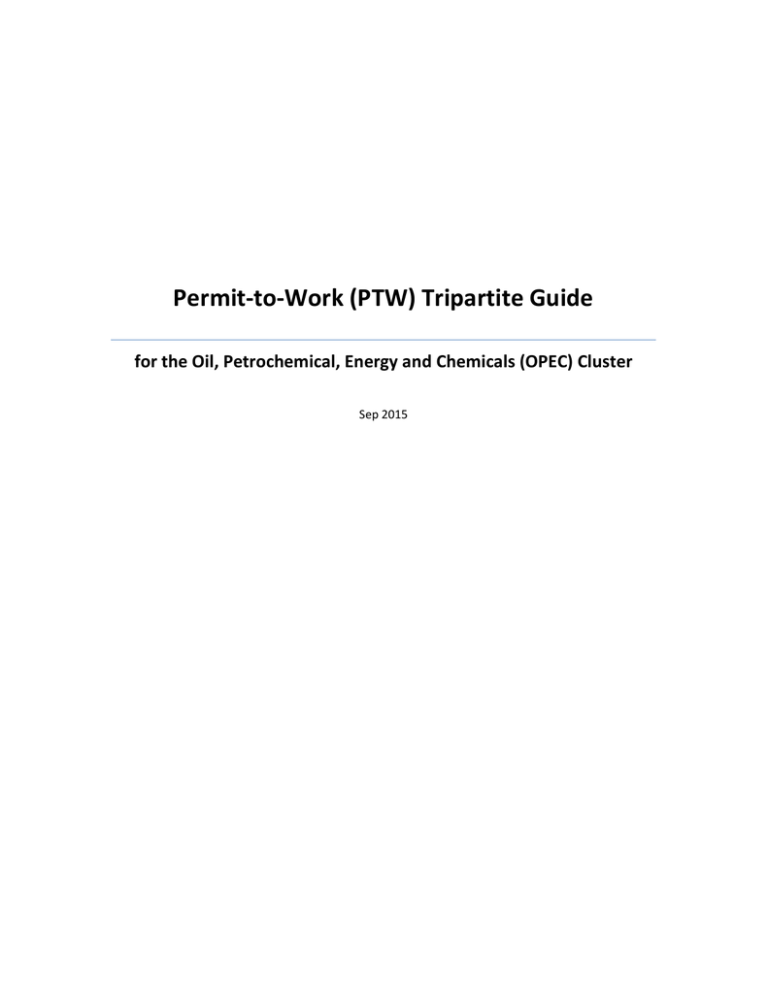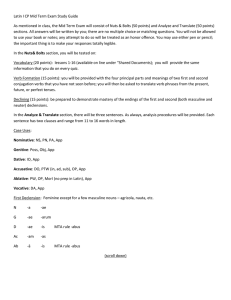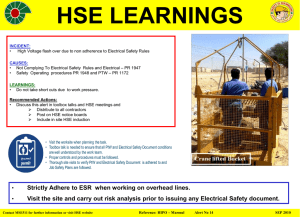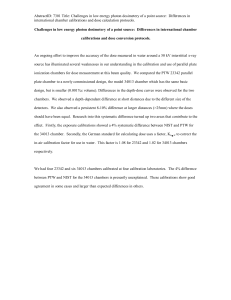Tripartitie Guideline on Permit-to-Work for the
advertisement

Permit-to-Work (PTW) Tripartite Guide for the Oil, Petrochemical, Energy and Chemicals (OPEC) Cluster Sep 2015 Permit-to-Work (PTW) Guide for Oil, Petrochemical, Energy and Chemicals (OPEC) Cluster 1.0 Foreword OPEC Cluster handles chemicals including flammables and other hazard substances. Therefore, effective management of hazards, including the implementation of a safe system of work is vital. The permit-to-work (PTW) system is an integral part of a safe system of work and can help in the management of wide range of work activities in the OPEC industry. The OPEC Cluster has been the forerunner in implementing PTW system, majority of which are based on corporate practices. Good communication has always been the critical foundation of establishing a safe workplace and good working relationship among various stakeholders. While this has already been well-observed in the OPEC cluster, this guide serves to reinforce guiding principles specific to the implementation and use of PTW systems in the OPEC cluster. The guide is jointly developed by the National Trade Union Congress (NTUC) and its unions under OPEC cluster, Singapore Chemical Industry Council (SCIC) and Ministry of Manpower (MOM). 2.0 Introduction The Workplace Safety and Health Act (WSH Act), governing the safety and health of workplaces, places duties on a number of stakeholders, such as employers, principals etc. The Act also requires employees to cooperate with their employers in order to comply with the provisions of this Act. Notwithstanding this, employers and principals directing the manner in which work is carried out are entrusted with ultimate responsibility to provide a safe work environment and ensure safe execution of work. What is a PTW? PTW is part of a safety and health management system. PTW is a formal authorisation system used in an organisation to control selected work activities to ensure safe execution onsite. It is a means of hazards communication between plant occupier, PTW authority and PTW user. PTW should be considered whenever there is any work which may adversely affect the safety of personnel, the plant or the environment. They are generally applied to non-routine work activities. In addition to PTW, other precautions should be taken, which may include process or electrical isolation, access barriers, safe method statements, training and others. All these measures are to be identified in the risk assessments before undertaking any work activity. Ultimately, safe execution of work can only be achieved by the combined efforts of those planning for, preparing for, supervising and carrying out the work. Page 2 of 9 3.0 Essentials of PTW system A general schematic of the parties involved in the PTW and their general responsibilities are: Occupiers / Site Management PTW Authority •Establish PTW system •Ensure sufficient resources are provided to enable PTW to be properly implemented •Monitor PTW to ensure that it is effective and correctly applied •Audit and review PTW periodically •Provide training and ensure competencies of all relevant employees and contractors involved in PTW PTW User •Ensure PTW User understands PTW and is competent to carry out the duties •Review potential incompatibilities of multiple jobs •Issue PTW to PTW User •Conduct site inspections, where necessary, to check and monitor site conditions and ensure PTW requirements are met •Apply PTW before start of work •Execute work activity in accordance with PTW, work procedures and site requirements •Follow precautions and safety measures as stated in PTW, work procedures and site instructions and requirement •Close off PTW and communicate with PTW Authority upon completion of work The essential features of a PTW system include - Clear identification of the types of work requiring PTW - Clear roles and responsibilities of personnel involved in PTW processes - Provision of effective training and clear instructions to all roles involved in the PTW - Proper authorisation of designated work, based on work nature or work of any type within certain designated areas - Clear specification of the necessary safeguards or precautions for a job activity - Site surveillance and supervision of work activities are carried out as intended - Conduct of risk assessments and implementation of risk control measures - Complete documentation of the entire PTW system including all procedures, roles and responsibilities, training and arrangements for work activities that may interact or be incompatible with one another. It is imperative that occupier/site management consult parties that will be involved in the PTW when developing the system. This consultative approach enhances ownership and communication, will lead to an effective PTW system. Page 3 of 9 4.0 Roles & Responsibilities 4.1 Occupiers / Site Management Occupiers / site management have the overall responsibility for ensuring proper PTW systems are established and implemented. Anyone who is involved in or in connection with any work requiring PTW has the responsibilities and duties under PTW system. It is important that all parties involved in PTW, employees, contractors and etc, are adequately trained and understand their responsibilities and duties under PTW. The primary responsibility of the occupier / site management is to provide a safe work environment for both employees and contractors and to ensure adequate safety measures are taken at work. In addition, the occupier / site management should, as appropriate, ensure the following: (i) An appropriate and comprehensive PTW system is implemented in consultation with relevant employees. (ii) All categories of work requiring PTW are identified. Permits contain a clear description of the work, its location, equipment brought on site, if any, start time and estimated duration where possible, etc. (iii) Sufficient resources, including manpower, are provided to enable the PTW system to be properly implemented. (iv) Roles and responsibilities of any appointed person are clearly defined and are transparent. (v) A list of personnel with their appointed roles under the PTW is maintained. (vi) All personnel, including contractors, working within the permit system are given sufficient training for purposes of carrying out their duties. (vii) Clear communications and documentations are made accessible to staff undertaking the appointed roles. (viii) Comprehensive procedures are developed and documented to ensure proper planning, coordination, issuance and closure of permits. Procedures should also address arrangements for work activities that may interact or be incompatible with one another. Where appropriate, arrangement for emergencies arising from specific work activity should be considered in the PTW. (ix) There is an established mechanism for resolution of differences arising from PTW matters. Employees, including contractors should be encouraged to escalate to the management of any irregularity, including non-compliances of PTW issues. (x) Proper shift handing-over procedure is established to ensure the incoming PTW Authority is apprised of the ongoing or suspended permits. (xi) A system of monitoring, auditing and reviewing is established to ensure the PTW system is correctly applied and effective. (xii) Copies of permits and records of their issuance are kept for a specified period to enable auditing or for incident investigation or as required by the law. (xiii) In any event of modification to the PTW system, the company should, where appropriate, conduct a job evaluation on the affected parties to assess the impact on their workload. 4.2 PTW Authority The PTW Authority serves the pivotal role of ensuring all the safety precautions of the work activities are in place before permitting the job execution. The primary responsibilities of the PTW Authority are to ensure the Page 4 of 9 site has been properly prepared and the necessary requirements are in place before authorisation of the permit. Therefore, the PTW Authority must: - Be competent and understand the hazards associated with the work which the permit is applied for; and - Have the power to approve or reject the PTW application without being pressurised to do so. In other words, with powers vested in any appointed role in respect to the authorisation of the commencement of work, there must be the corresponding powers to reject the permit should conditions warrant it. In order to do so, the appointed roles must have the necessary training, experiences and skills. Typical knowledge and competence of persons acting as PTW Authority are given in Appendix. In addition, the PTW Authority also has the responsibilities to ensure that (i) PTW User understands the permit that is applied for and the intended work to be carried out. (ii) All foreseeable hazards and the associated safeguards for the intended work, including PPEs, have been identified on the permit. Physical site checks, including the verification of the equipment / area conditions and safeguards implemented, are to be carried out to ensure work can be done safely. This could be done jointly with the PTW User. (iii) No incompatible work in the vicinity that could interact with the intended work is carried out concurrently. (iv) Process-related hazards have been communicated to the PTW Users. (v) Appropriate arrangements for emergencies are considered in the application of PTW. (vi) Effective and appropriate communication to personnel who may be affected by the PTW applied. (vii) PTW User adheres to the conditions stated on the permit (e.g. physical boundaries, type of work, permit validity period) while executing the work. (viii) In the event work is extended beyond shift timing, proper handing-over process is conducted and sufficient time is spent on shift handover to discuss all ongoing or suspended permits with the incoming PTW Authority. (ix) No person shall act as both the PTW User and PTW Authority for a permit. No person shall authorise a PTW for work that they will carry out themselves. 4.3 PTW User The PTW Users, such as contractors, are the parties who execute the work. For the safe execution of work, it is important that the PTW User works closely with the PTW Authority during the application of the permit. In addition, the PTW User must adhere to the conditions stipulated in the PTW at all times when carrying out the work. Therefore, the PTW user has to: (i) Understand the work hazards and implement all the safeguards before starting the work. (ii) Communicate the work-related hazards to the PTW Authority when applying the PTW. (iii) Ensure that all workers are aware and adhere to the conditions stipulated in the PTW. Page 5 of 9 (iv) Ensure that all workers have received the appropriate training to perform the work competently and safely. (v) Ensure upon completion or suspension of work, the site is left in a safe condition and the PTW Authority is informed. (vi) When in doubt or conditions change which could give rise to unsafe or potentially unsafe situations, stop work and get advice immediately from the PTW Authority. Page 6 of 9 5.0 Training and Competency Training provides the foundation for effective implementation of a permit-to-work system. It is important that each person is adequately trained to know the roles and responsibilities and carry them out properly under the PTW system. In order to achieve this, organisation should: i. Build competency through a combination of training, briefings, refresher courses, field observations and engagements with workers, field and written assessments so that the appointed roles possess sufficient knowledge to enable them to recognise potential hazardous situations, know their responsibilities in accordance with legal requirements and their roles in ensuring a safe work environment. ii. Establish a competency matrix as well as keep records of training and assessments conducted. This allows the company to identify the future training needs. iii. Evaluate the effectiveness of the training conducted and periodically review the training programmes through feedback. 6.0 Documentation, Communication & Resolution Effective documentation and communication within the PTW system is extremely essential to ensure transparency, seamless flow of information before, during and after the work. Special attention should be paid on the following: i. Documentation of PTW systems and its procedures should be made accessible to enable consistent application across the organisation. ii. Potential hazards at the intended work area and its surroundings, any precaution to be taken should be clearly communicated to the PTW Users and any other person who may be affected by the work. iii. PTW Users should inform the PTW Authority of the work scope, work method, number of workers involved, any special tools used, and if there are changes in the work conditions which may affect the validity of the permit. iv. PTW Users should ensure that every member of the working team understands the hazards, precautionary measures and the action to be taken in the event of an emergency. v. There must be effective and close communication between the Occupier, PTW Authority and PTW Users. Mutual trust and open communication between employees and management is an integral to a successful safety and health management system. In the event of differing views on PTW, i. Employees should bring up the issue to the WSH committee attention for resolution. ii. Where the issue cannot be resolved at the company-union level, assistance could be sought from a neutral party to facilitate resolution. Page 7 of 9 7.0 Abbreviations ALARP OPEC PTW WSH As Low as Reasonably Practicable Oil, Petrochemicals, Energy and Chemicals Permit-to-Work Workplace Safety and Health 8.0 References i. UK Health and Safety Executive, HG250 – Guidance on Permit-to-work systems (2005) ii. OGP International Association of Oil & Gas Producers, Guidelines on permit-to-work (PTW) system Page 8 of 9 Appendix Knowledge and Competence for Persons Acting as PTW Authority Persons acting as PTW Authority should be able to demonstrate knowledge and competence, including but not limited to, in the following areas: • Process unit operations, where applicable. • Plant and equipment layout. • Potential process hazards. • The means of managing/mitigating hazards before issuing a permit. • Specific responsibilities associated with issuing permits. • Applicable legal requirements. • Company rules and regulations applicable to the operation of the PTW system. • Principles of a PTW system. • Understanding of the types of permits, supporting certificates and other documentation (e.g. risk assessments, method statements etc). • Shift handover requirements. • Actions to be taken in emergency situations. • Auditing and monitoring requirements for the PTW system. • Case history of accidents or near misses involving failure of a PTW system. Page 9 of 9






